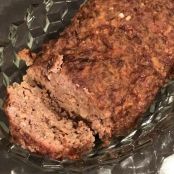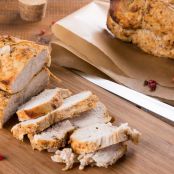Turkey- EASIEST ROAST TURKEY AND GRAVY
By marie2
Ingredients
- For the turkey:
- Serves 10-12
- Recipe by Christine Byrne
- INGREDIENTS
- One 14-16 lb turkey
- 4 lemons, halved
- 1/2 cup (1 stick) unsalted butter, at room temperature
- 3 tablespoons kosher salt
- freshly ground pepper, to taste
- 2 cups low sodium chicken broth
- For the gravy:
- 1/2 cup pan drippings from the turkey
- 1/3 cup all-purpose flour
- 4 cups low-sodium chicken broth
- 1 teaspoon salt
- 5 sprigs thyme
- Equipment
- Roasting rack and pan large enough for turkey
- Paper towels
- Meat thermometer
- Wooden spoon
- Aluminum foil
- Oven
- Small strainer
- Small bowl
- Whisk
- Medium sauce pot
Details
Preparation
Step 1
INSTRUCTIONS
For the turkey:
1. If you’re using a frozen turkey, you’ll need to thaw it in advance, and the easiest way to do this is in the refrigerator. How long it will take to thaw depends on weight: Whole turkeys thaw at a rate of 4 lbs per day, so a 16 pound turkey will take 4 days to thaw, and a 20 pound turkey will take 5 days, etc.
2. When you’re ready to roast your turkey, take it out of the fridge and let it sit on the counter, in its packaging, about an hour — until it is room temperature. Also take out the stick of butter; you’ll need that to be room temperature, too. Preheat oven to 450°F and put one of your oven racks on the lowest rung. You only need a single rack for the turkey, so take any other racks out of the oven and set them aside.
3. When the turkey is room temperature, take it out of its packaging, preferably over the sink because all kinds of raw turkey juices will come pouring out. You’ll probably find a plastic bag inside the cavity of the turkey filled with tiny organs (called the “giblets”) and a turkey neck; some people use these for gravy, but you can throw the whole bag away.
4. Put the turkey on a large cutting board, and dry it really, really well with paper towels. Be sure to dry the inside of the cavity really well, as well as the outside of the turkey. When turkey is completely dry, sprinkle two tablespoons of salt evenly all over the outside of the turkey, along with some freshly ground pepper. Sprinkle the remaining tablespoon of salt inside the cavity of the turkey.
5. Now you’re going to put butter UNDERNEATH the skin on the turkey breast meat: Entering from the neck, slide your hand between the skin and breast meat, then crawl your hand along the surface of both breasts underneath the skin, separating the skin from the meat as you move along. Be careful not to rip the skin. Once you’ve got the skin separated from the meat, rub the stick of soft butter underneath the skin on top of the breast meat. It should be spread out to cover both breasts.
6. Put the roasting rack inside the roasting pan, and place the turkey — breast side up (meaning, the legs will be in the air, not down on the rack) — on the roasting rack. Stuff the lemon halves inside the cavity of the turkey. Pour 2 cups of chicken broth and 1 cup of water into the bottom of the roasting pan. (Fat will drip down from the turkey during cooking; the liquid in the pan will keep that fat from burning and filling your kitchen with smoke.)
7. Roast turkey at 450°F for 45 minutes, then turn the oven temperature down to 375°F and continue roasting for another 2-2 ½ hours. If the skin of your turkey starts to get dark brown before the rest of the turkey is done, take a piece of aluminum foil and lay it gently over whatever parts of the skin are burning. Also, if the liquid in the bottom of the roasting pan evaporates and the fat in the pan starts burning, just pour more water in. The exact roasting time will depend on the weight of your turkey and your oven, and the only way to tell if the bird is cooked is by taking its temperature with meat thermometer. After the turkey has been roasting for 2 hours and 45 minutes, take it out of the oven and insert a meat thermometer into the thickest part of the thigh (right where the thigh meets the breast). When the thermometer reads 165°F, your turkey is done. If not, put it back in the oven and check the temperature every 20 minutes.
8. Once the thigh meat temperature reaches 165°F, take it out of the oven and let it sit on the rack in the roasting pan for about five minutes, just to let it cool a little bit so that it’s easier to handle. After five minutes, stick a meat fork or a wooden spoon inside the cavity of the turkey so you can lift it out of the roasting pan onto a large cutting board. Let it rest on the cutting board for another 20 minutes before you start carving; this way, the juices inside the turkey will absorb into the meat and won’t just gush out when you cut into it.
9. The easiest way to carve a turkey is to quarter it first — meaning you cut the legs off first, then cut each breast off of the turkey carcass — then slice it into pieces. See how to carve a turkey here.
For the gravy:
1. When the turkey is done and you take it out of the roasting pan, it’s time to make gravy! First, take the rack out of the roasting pan and put it aside — you can put it in the sink to be washed, you won’t need it again. There will be a pool of fat and some liquid in the roasting pan, and maybe some burnt bits stuck to the bottom. Set up a small strainer over a medium bowl, and pour the fat/liquid (these are the pan drippings) through the strainer and into the bowl. No need to scrape the bottom of the pan, just pour whatever comes out easily. When your pan drippings are strained, measure out ½ cup and throw the rest away.
2. In a medium saucepan, heat the ½ cup of pan drippings over medium heat until it is hot but not quite bubbling. Add ⅓ cup of flour and whisk the mixture together vigorously, so that the flour doesn’t get lumpy. Keep whisking for about 3 minutes (it’s important that you whisk quickly!), and watch as the mixture gets smoother and thicker. It should also start to smell slightly toasted. After 3 minutes, the mixture should be the consistency of paste (this cooked fat/flour mixture is called a roux).
3. Keep whisking, and start to SLOWLY pour the 4 cups chicken stock into the saucepan with the roux. Pour very slowly — it should take at least 45 seconds to pour all of the liquid in. As soon as all of the stock is in, add the thyme. You don’t have to whisk as quickly now, just enough so that the gravy doesn’t get lumpy.
4. Bring the gravy to a boil, then lower your heat so that the gravy is barely simmering (there should be a few little bubbles around the side of the pot). Add salt, stop whisking, and let the gravy simmer for about 10 minutes, at which point it should be thickened. If it’s not thick enough, keep simmering for another minute or so. Pull the sprigs of thyme out with a spoon.
5. Taste to see if the gravy needs more salt, and add as necessary. Then pour the gravy into a gravy boat or small bowl, and serve immediately (if you let the gravy sit too long before serving, it will get too thick and a skin will form on the top).
You'll also love
-
 Creamy Lobster Macaroni and Cheese
5/5
(3 Votes)
Creamy Lobster Macaroni and Cheese
5/5
(3 Votes)
-
 Slow Cooker Venison Roast
4.8/5
(4 Votes)
Slow Cooker Venison Roast
4.8/5
(4 Votes)
-
 Hawaiian BBQ Turkey Flatbread Pizza
4.3/5
(15 Votes)
Hawaiian BBQ Turkey Flatbread Pizza
4.3/5
(15 Votes)



Review this recipe